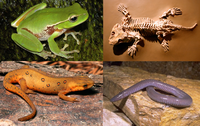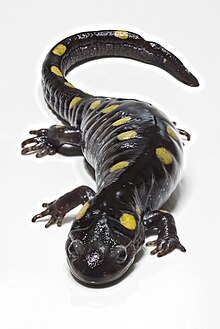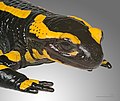User:The Transhumanist/Sandbox144
Introduction
Selected amphibian type
Salamanders are a group of amphibians typically characterized by their lizard-like appearance, with slender bodies, blunt snouts, short limbs projecting at right angles to the body, and the presence of a tail in both larvae and adults. All ten extant salamander families are grouped together under the order Urodela from the group Caudata. Urodela is a scientific Latin term based on the Ancient Greek οὐρά δήλη: ourà dēlē "conspicuous tail". Caudata is the Latin for "tailed ones", from cauda : "tail".
Salamander diversity is highest in eastern North America, especially in the Appalachian Mountains; most species are found in the Holarctic realm, with some species present in the Neotropical realm. Salamanders never have more than four toes on their front legs and five on their rear legs, but some species have fewer digits and others lack hind limbs. Their permeable skin usually makes them reliant on habitats in or near water or other cool, damp places. Some salamander species are fully aquatic throughout their lives, some take to the water intermittently, and others are entirely terrestrial as adults.
This group of amphibians is capable of regenerating lost limbs as well as other damaged parts of their bodies. Researchers hope to reverse engineer the regenerative processes for potential human medical applications, such as brain and spinal cord injury treatment or preventing harmful scarring during heart surgery recovery. The remarkable ability of salamanders to regenerate is not just limited to limbs but extends to vital organs such as the heart, jaw, and parts of the spinal cord, showing their uniqueness compared to different types of vertebrates. This ability is most remarkable for occurring without any type of scarring. This has made salamanders an invaluable model organism in scientific research aimed at understanding and achieving regenerative processes for medical advancements in human and animal biology. (Full article...)
Selected frog article
The Pipidae are a family of primitive, tongueless frogs. There are 41 species in the family, found in tropical South America (genus Pipa) and sub-Saharan Africa (the three other genera). (Full article...)
Selected salamander article
Salamanders are a group of amphibians typically characterized by their lizard-like appearance, with slender bodies, blunt snouts, short limbs projecting at right angles to the body, and the presence of a tail in both larvae and adults. All ten extant salamander families are grouped together under the order Urodela from the group Caudata. Urodela is a scientific Latin term based on the Ancient Greek οὐρά δήλη: ourà dēlē "conspicuous tail". Caudata is the Latin for "tailed ones", from cauda : "tail".
Salamander diversity is highest in eastern North America, especially in the Appalachian Mountains; most species are found in the Holarctic realm, with some species present in the Neotropical realm. Salamanders never have more than four toes on their front legs and five on their rear legs, but some species have fewer digits and others lack hind limbs. Their permeable skin usually makes them reliant on habitats in or near water or other cool, damp places. Some salamander species are fully aquatic throughout their lives, some take to the water intermittently, and others are entirely terrestrial as adults.
This group of amphibians is capable of regenerating lost limbs as well as other damaged parts of their bodies. Researchers hope to reverse engineer the regenerative processes for potential human medical applications, such as brain and spinal cord injury treatment or preventing harmful scarring during heart surgery recovery. The remarkable ability of salamanders to regenerate is not just limited to limbs but extends to vital organs such as the heart, jaw, and parts of the spinal cord, showing their uniqueness compared to different types of vertebrates. This ability is most remarkable for occurring without any type of scarring. This has made salamanders an invaluable model organism in scientific research aimed at understanding and achieving regenerative processes for medical advancements in human and animal biology. (Full article...)
The page "User:The Transhumanist/Sandbox144/box-header" does not exist. The page "User:The Transhumanist/Sandbox144/DYK/16" does not exist.
Picture slideshow
Selected toad article

Scaphiopus holbrookii, commonly known as the eastern spadefoot, is a species of American spadefoot toad (family Scaphiopodidae) endemic to the eastern United States. It is not considered a true toad, with Bufonidae being the family of "true toads". (Full article...)
Selected caecilian article
The Scolecomorphidae (from Greek: σκώλεκώς skólekós, 'wormlike' and Greek: μορφή morphḗ, 'form') are a family of caecilians also known as tropical caecilians, buried-eyed caecilians, or African caecilians. They are found in Cameroon in West Africa, and Malawi and Tanzania in East Africa. Caecilians are legless amphibians which superficially resemble worms or snakes.
Scolecomorphids have only vestigial eyes, which are attached to the base of a pair of tentacles underneath the snout. Unlike other caecilians, they have only primary annuli; these are grooves running incompletely around the body, giving the animal a segmented appearance. All other caecilians have a complex pattern of grooves, with secondary or tertiary annuli present. Also uniquely amongst tetrapods, the scolecomorphids lack a stapes bone in the middle ear.
At least some species of scolecomorphids give birth to live young, retaining the eggs inside the females' bodies until they hatch into fully formed offspring, without the presence of a free-living larval stage. (Full article...)
Categories
Topics
Related portals
Associated Wikimedia
The following Wikimedia Foundation sister projects provide more on this subject:
-
Commons
Free media repository -
Wikibooks
Free textbooks and manuals -
Wikidata
Free knowledge base -
Wikinews
Free-content news -
Wikiquote
Collection of quotations -
Wikisource
Free-content library -
Wikiversity
Free learning tools -
Wiktionary
Dictionary and thesaurus

























































